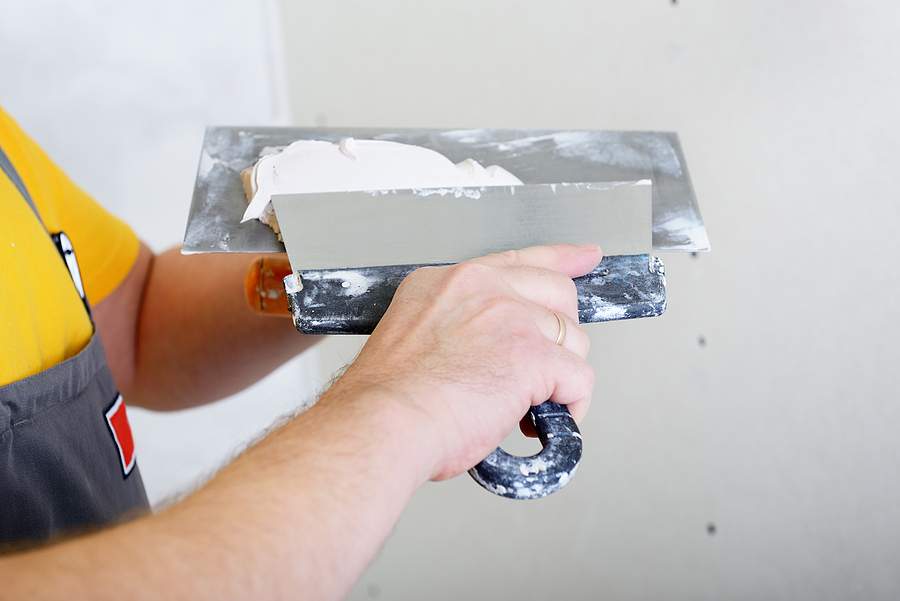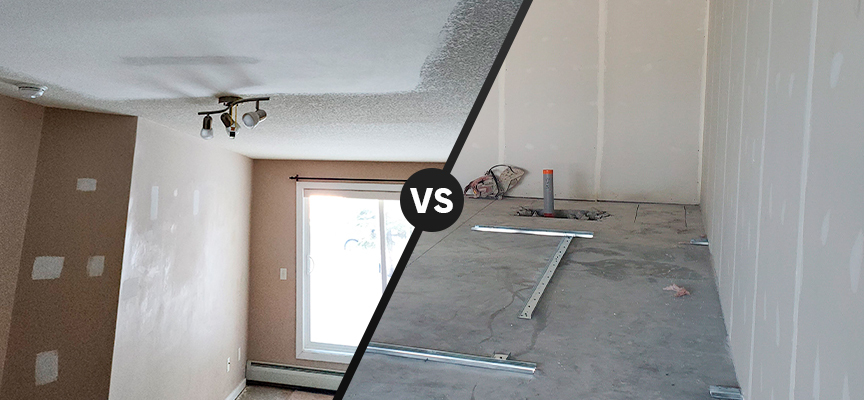Partner with experienced drywall contractors to achieve flawless results in every Interior Painting project.
A Comprehensive Guide to Mastering Drywall Fixing and Setup
This overview uses a detailed exploration of drywall repair service and installment, dealing with both beginners and experienced experts. It details essential tools, techniques for patching and hanging sheets, and the vital completing procedures. Interior Painting. By understanding common challenges, individuals can accomplish sleek results. Understanding these skills not only boosts one's home however also develops self-confidence in DIY endeavors. What foundational tips will ensure a successful project from beginning to end?
Important Devices for Drywall Repair and Setup
When beginning on drywall repair and setup, a couple of vital tools can greatly boost the efficiency and top quality of the job. A drywall blade, typically offered in different dimensions, is crucial for applying joint substance and smoothing joints. A taping knife is also necessary for feathering sides and making sure a seamless coating. Additionally, a drywall saw or energy knife enables accurate cutting of drywall sheets to fit any room.

Step-by-Step Guide to Patching Holes
Patching holes in drywall is a simple procedure that can recover the wall's look and integrity. To begin, the area around the hole should be cleansed and any type of loosened particles removed. For small holes, a straightforward spackle or joint compound can be used with a putty knife. Larger openings may require a patch; an item of drywall can be cut to fit the opening, protected with adhesive or screws, and then taped around the edges. As soon as the spot remains in area, joint substance is applied over the spot and feathered bent on mix with the bordering wall. After the substance dries, fining sand is essential to accomplish a smooth coating. Finally, the fixed area can be topped and repainted to match the remainder of the wall. This technique guarantees a seamless repair, improving the total look of the drywall and preserving its structural honesty.
Strategies for Hanging Drywall Sheets
After effectively fixing openings in drywall, the following action involves hanging brand-new drywall sheets to develop a smooth surface area. To achieve this, one have to begin by measuring the wall surface space precisely and reducing the drywall sheets to fit. It is essential to hang the sheets horizontally for better structural honesty, beginning with the top and working downwards.
Using a drywall lift can see post streamline the process, particularly for ceiling installations. As soon as placed, safeguarding the sheets with drywall screws at periods of concerning 12 inches along the edges and 16 inches in the field is important. This assures a solid hold and reduces the danger of sagging. For corners, the sheets must be reduced to fit well, permitting for cleaner seams. Lastly, it is recommended to surprise the joints between sheets to enhance the total framework, creating an extra durable coating all set for the next stage in the drywall installation procedure.
Completing Touches: Taping and Mudding
Finishing the drywall setup involves the important steps of taping and mudding, which assure a smooth and sleek surface. Taping needs the application of joint tape over the seams in between drywall sheets. Interior Painting. This tape can be either paper or fiberglass mesh, with each type offering unique advantages. After taping, the following action is mudding, where joint compound, or "mud," is related to cover the tape and fill up any kind of imperfections
Utilizing a drywall blade, the substance needs to be spread evenly, ensuring a feathered edge to lessen visible modifications. Several coats are frequently needed, with fining sand in between each layer to accomplish a seamless surface area. Cautious interest throughout this procedure is crucial, as it greatly drywall contractor impacts the final appearance of the wall. With the right method and patience, the end result will be a remarkable foundation ready for painting or completing touches.
Typical Mistakes to Prevent in Drywall Projects

An additional usual error is not allowing adequate drying out time between layers, which can catch wetness and jeopardize the surface. Furthermore, overlooking to feather the edges effectively can produce visible lines and flaws. Skipping sanding or utilizing inappropriate methods might leave harsh spots. By recognizing these risks, people can greatly enhance the quality of their drywall projects and attain a professional-looking surface.
Often Asked Questions
Can I Fix Drywall Without Specialist Assist?
Yes, one can repair drywall without expert aid. With the right devices, products, and guidance, people can efficiently take care of small repairs. Substantial damage might require specialist competence for excellent outcomes and resilience.
Just How Long Does Drywall Compound Require To Dry?
Drywall compound usually takes between 24 to 2 days to see here now completely dry completely, depending upon variables such as humidity and temperature level. Thinner layers may dry much faster, while thicker applications need more time for suitable results.
What's the most effective Kind of Paint for Drywall?
The best kind of paint for drywall is usually a water-based latex paint. It offers exceptional coverage, longevity, and ease of application, making it ideal for interior walls while enabling simple cleaning with soap and water.

Exactly how Do I Stop Mold on Drywall?
To avoid mold on drywall, guarantee proper ventilation, control humidity degrees, use mold-resistant materials, and immediately deal with any type of leaks. Regular inspections and prompt removal of water damages are also necessary for long-lasting prevention.
Is Drywall Recyclable After Elimination?
Drywall is recyclable after elimination, supplied it is without pollutants like mold, paint, or other harmful materials. Reusing centers can process it right into brand-new products, advertising sustainability and decreasing land fill waste in construction.
When beginning on drywall repair work and setup, a couple of essential devices can considerably enhance the effectiveness and quality of the work. After effectively repairing holes in drywall, the following step includes hanging brand-new drywall sheets to create a smooth surface area. Finishing the drywall setup entails the crucial steps of mudding and taping, which guarantee a polished and smooth coating. Achieving a sleek finish in drywall projects can be difficult, and a number of usual mistakes can weaken the quality of the job. Yes, one can fix drywall without professional help.